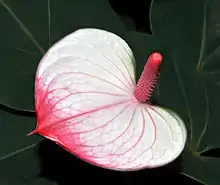Anthurium
Anthurium (/ænˈθjuːriəm/;[2] Schott, 1829) is a genus of about 1,000[3][4] species of flowering plants, the largest genus of the arum family, Araceae.[3] General common names include anthurium, tailflower, flamingo flower,[5] and laceleaf.[6][7][8]
| Anthurium | |
|---|---|
 | |
| Anthurium sp. | |
| Scientific classification | |
| Kingdom: | Plantae |
| Clade: | Tracheophytes |
| Clade: | Angiosperms |
| Clade: | Monocots |
| Order: | Alismatales |
| Family: | Araceae |
| Subfamily: | Pothoideae |
| Tribe: | Anthurieae |
| Genus: | Anthurium Schott |
| Species | |
|
See list of species | |
 | |
| Range of the genus Anthurium | |
| Synonyms[1] | |
| |
The genus is native to the Americas, where it is distributed from northern Mexico to northern Argentina and parts of the Caribbean.[9]
Description and biology
Anthurium is a genus of herbs often growing as epiphytes on other plants. Some are terrestrial. The leaves are often clustered and are variable in shape. The inflorescence bears small flowers which are perfect, containing male and female structures. The flowers are contained in close together spirals on the spadix. The spadix is often elongated into a spike shape, but it can be globe-shaped or club-shaped. Beneath the spadix is the spathe, a type of bract. This is variable in shape, as well, but it is lance-shaped in many species. It may extend out flat or in a curve. Sometimes it covers the spadix like a hood. The fruits develop from the flowers on the spadix. They are juicy berries varying in color, usually containing two seeds.[10]
The spadix and spathe are a main focus of Anthurium breeders, who develop cultivars in bright colors and unique shapes. Anthurium scherzerianum and A. andraeanum, two of the most common taxa in cultivation, are the only species that grow bright red spathes. They have also been bred to produce spathes in many other colors and patterns.[11]
Anthurium plants are poisonous due to calcium oxalate crystals. The sap is irritating to the skin and eyes.[5]
Cultivation

Like other aroids, many species of Anthurium plant can be grown as houseplants, or outdoors in mild climates in shady spots, including Anthurium crystallinum and Anthurium clarinervium with its large, velvety, dark green leaves and silvery white venation. Many hybrids are derived from Anthurium andraeanum or Anthurium scherzerianum because of their colorful spathes. They thrive in moist soils with high organic matter. In milder climates the plants can be grown in pots of soil. Indoors plants thrive at temperatures of 16–22 °C (61–72 °F) and at lower light than other house plants. Wiping the leaves off with water will remove any dust and insects. Plants in pots with good root systems will benefit from a weak fertilizer solution every other week. In the case of vining or climbing Anthuriums, the plants benefit from being provided with a totem to climb.
Propagation
Anthurium can be propagated by seed or vegetatively by cuttings. In the commercial Anthurium trade, most propagation is via tissue culture.[12]
Species
For a full list, see the List of Anthurium species.
In 1860 there were 183 species known to science, and Heinrich Wilhelm Schott defined them in 28 sections in the book Prodromus Systematis Aroidearum.[13] In 1905 the genus was revised with a description of 18 sections.[14] In 1983 the genus was divided into the following sections:[15]
- Belolonchium
- Calomystrium
- Cardiolonchium
- Chamaerepium
- Cordatopunctatum
- Dactylophyllium
- Decurrentia
- Digitinervium
- Gymnopodium
- Leptanthurium
- Pachyneurium
- Polyphyllium
- Polyneurium
- Porphyrochitonium
- Schizoplacium
- Semaeophyllium
- Tetraspermium
- Urospadix
- Xialophyllium
Gallery
 Flamingo Flower
Flamingo Flower Anthurium polyschistum
Anthurium polyschistum Anthurium digitatum inflorescence
Anthurium digitatum inflorescence Anthurium scandens fruits and leaves
Anthurium scandens fruits and leaves

.jpg.webp)
 Anthurium andraeanum cv. Previa
Anthurium andraeanum cv. Previa
See also
- Spathiphyllum, similar looking plant genus of same family
References
- Kew World Checklist of Selected Plant Families
- Sunset Western Garden Book, 1995:606–607
- Mantovani, A. and T. E. Pereira. (2005). Anthurium (section Urospadix; subsection Flavescentiviridia). Rodriguesia 56(88), 145–60.
- Haigh, A. Araceae. Archived 2020-11-12 at the Wayback Machine Neotropical Araceae. Royal Botanic Gardens, Kew.
- Anthurium spp. Archived 2013-10-03 at the Wayback Machine Poisonous Plants of North Carolina. North Carolina State University.
- Anthurium. ITIS.
- Govaerts, R. & Frodin, D.G. (2002). World Checklist and Bibliography of Araceae (and Acoraceae): 1–560. The Board of Trustees of the Royal Botanic Gardens, Kew.
- Nadruz Coelho, M.A., Waechter, J.L. & Mayo, S.J. (2009). Revisão taxonômica das espécies de Anthurium (Araceae) seção Urospadix subseção Flavescentiviridia. Rodriguésia; Revista do Instituto de Biologia Vegetal, Jardim Botânico e Estaçao Biologica do Itatiaya 60: 799–864.
- Croat, T. (1983). A revision of the genus Anthurium (Araceae) of Mexico and Central America. Part 1: Mexico and Middle America. Ann. Missouri Bot. Gard. 70: 211–417.
- Croat, T. B. Anthurium description. aroid.org
- Anthurium scherzerianum (flamingo flower). Archived 2013-10-23 at the Wayback Machine Royal Botanic Gardens, Kew.
- Chen, J., et al. Cultural guidelines for commercial production of interiorscape Anthurium. ENH956. Environmental Horticulture. Florida Cooperative Extension Service. University of Florida IFAS. Published 2003, revised 2009.
- Schott, H. W. Prodromus Systematis Aroidearum. Wien. 1860.
- Engler, A. (1905). Araceae-Pothoideae. Das Pflanzenreich IV. 23B, Heft 21, pp. 1–330.
- Sections of Anthurium. Archived December 31, 2007, at the Wayback Machine aroid.org
External links
 Media related to Anthurium at Wikimedia Commons
Media related to Anthurium at Wikimedia Commons
